Punjab State Board PSEB 9th Class Science Book Solutions Chapter 12 Sound Textbook Exercise Questions and Answers.
PSEB Solutions for Class 9 Science Chapter 12 Sound
PSEB 9th Class Science Guide Sound Textbook Questions and Answers
Question 1.
What is sound and how is it produced?
Answer:
Sound: Sound is a form of energy which produces in our ears the sensation of hearing. It is produced due to vibration of a body about its mean position.
How to produce sound? We can produce sound in different bodies by plucking, by rubbing, by blowing or by giving jolt. In other words, by producing vibration in bodies sound can be produced. By vibration we mean moving a body rapidly to and fro about its mean position.
![]()
Question 2.
Describe with the help of diagram, how compressions and rarefactions are produced in air near a source of sound?
Answer:
Sound in air gets propagated in the form of longitudinal wave motion consisting of regions of compressions and rarefactions. Consider, for example, a tuning, fork in a state of vibrations. [Fig.(a)] As prong moves towards right, it compresses the layer of air in contact with it. As air has elasticity, the compressed air tends to relieve itself of its strain and moves forward to right to compress the next layer and so on.
Thus, a wave of compression moves towards the right. At the point of compression, there is an increase of pressure and is shown in form of crest C. At the point of rarefaction of concentration of particles is least and has been shown as trough R.
When the prong moves towards left, a region of reduced pressure or rarefaction is produced towards right [Fig. (b)].
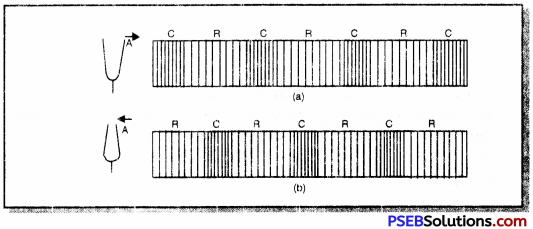
Thus, a wave of rarefaction starts moving towards right. This way a series of compressions arid rarefactions move in forward direction.
Question 3.
Cite an experiment to show that sound needs a material medium for its propagation.
Or
Describe an experiment to show that sound needs a material medium for its propagation.
Or
Describe an activity to show that sound is a mechanical wave and needs a material medium for its propagation.
Answer:
Sound needs material medium for propagation: Sound is a mechanical wave which needs a material medium to travel, (propagate) It can travel through air, water, steel, etc but cannot travel through vacuum. This can be demonstrated by the following experiment.

Experiment: Take an electric bell and a glass bell-jar. Suspend the electric bell in a bell jar with the help of a cork fitted in the mouth of the jar. Connect the bell jar to a vacuum pump as shown in Fig. Press the switch of electric bell when sound is heard.
Now work the exhaust pump and remove air from the jar slowly. As air is removed the sound becomes fainter and fainter. After sometime when most of the air is removed, a feeble sound will be heard. If the whole of the air from the jar is removed no sound of electric bell will be heard. This proves that material medium is needed for the propagation of sound.
Question 4.
Why is sound wave called longitudinal wave?
Answer:
Sound waves when travel through a medium, the particles of the medium move to and fro in the same direction in which the disturbance (wave) travels. That is why, the sound waves are called longitudinal waves.
![]()
Question 5.
Which characteristic of the sound helps you to identify your friend by his voice while sitting with others in a dark room.
Answer:
On the basis of quality or timbre of sound, we can identify our friend’s voice.
Question 6.
Flash and thunder are produced simultaneously. But thunder is heard a few seconds after the flash is seen. Why?
Answer:
The speed of sound (344 m s-1) is much smaller than the speed of light (3 × 108 m s-1). So thunder is heard a few seconds after the flash is seen although these are produced at the same time.
Question 7.
A person has a hearing range from 20 Hz to 20 KHz. What is the typical wavelength of sound waves in air corresponding to these frequencies? Take the speed of sound in air as 344 ms-1.
Solution:
Given speed of sound (υ) = 344 m s-1
Lower limit of frequency (ν1) = 20 Hz
Upper limit of audible frequency (ν2) = 20 KHz
= 20 × 1000 Hz.
= 20000 Hz
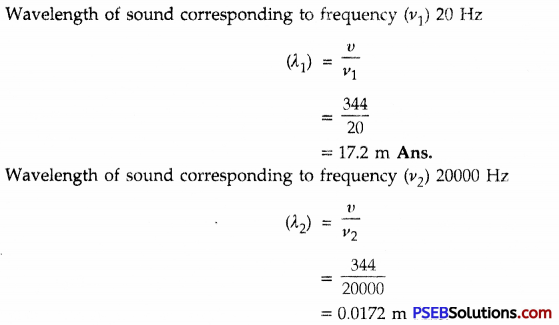
Question 8.
Two children are at opposite er Is of an aluminium rod. One strikes the end of the rod with a stone. Find the ratio of times taken by the sound wave in air and in aluminium to reach the second child.
Solution:
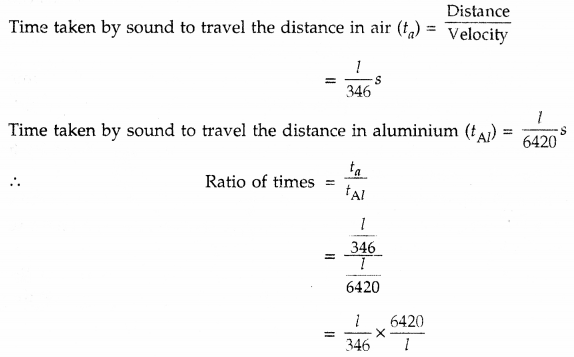

Question 9.
The frequency of source of sound is 100 Hz. How many times does it vibrate in a minute?
Solution:
Frequency of source sound = 100 Hz
i.e, Number of vibrations produced in 1 second = 100
Number of vibrations produced in 1 min = 60 s = 100 × 60 = 6000
![]()
Question 10.
Does sound follow the same laws of reflection as light does? Explain.
Answer:
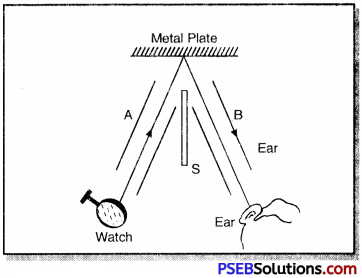
Yes, sound follows the same laws of reflection as light does. Like light sound is reflected from solid or liquid surface.
These laws are:
- First Law: The directions of incident sound and reflected sound make equal angles with the normal to the surface at the point of incidence.
i.e. \(\angle i=\angle r\) - Second Law: The incident sound wave, the reflected sound wave and normal to the reflecting surface at the point of incidence all lie in the same plane.
Question 11.
When a sound is reflected from a distant object, an echo is produced. Let the distance between the reflecting surface and the source of sound production remains the same. Do you hear echo sound on a hotter day?
Answer:
On a hotter day the speed of sound increases with the increase of temperature. So on that day reflected sound returns tq source earlier than 0.1 s. Hence a clear echo sound can not be heard.
Question 12.
Give two practical applications of reflection of sound waves.
Answer:

Stethoscope is doctor’s device which is used to hear the sound produced inside heart or lungs. The speed of sound of a patient’s heart beat is guided along the tube to the doctor’s ears by multiple reflection of sound.
2. The front part of musical instruments like megaphone or loudspeaker, horn, shehnai is made open and conical so that the sound waves produced may be reflected repeatedly and may be reflected repeatedly and may be sent forward towards the listeners.
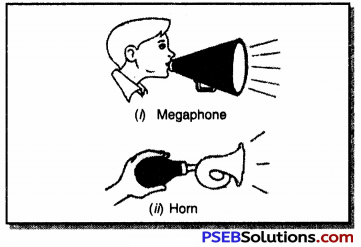
Question 13.
A stone is dropped from the top of a tower 500 m high into a pond of water at the base of the tower. When is the splash heard at the top? Given, g = 10 m s-2 and speed of sound = 340 m s-2.
Solution:
Here, initial velocity of sound (u) = 0
Height of the lower (i.e. distance covered) (S) = 500 m
Acceleration due to gravity (g) = 10 ms-2
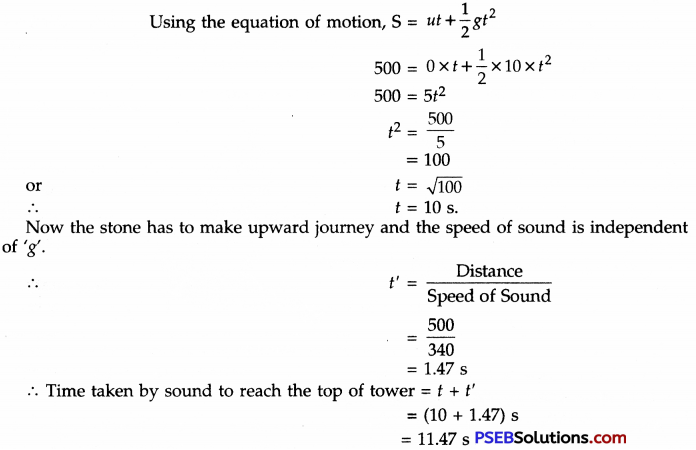
![]()
Question 14.
A sound wave travels at a speed of 339 m s-1. If its wavelength is 1.5 cm, what is the frequency of the wave? Will it be audible?
Solution:
Speed of sound (υ) = 339 ms-1
Wavelength of sound (λ) = 1.5 cm
= \(\frac {1.5}{100}\)
= 0.015 m
Frequency of wave (ν) =?
We know, frequency (ν) = \(\frac{υ}{\lambda}\)
= \(\frac {339}{0.015}\)
= 22600 Hz
Yes, sound waves are inaudible because these have frequency 22600 Hz which is not within the audible range 20 Hz to 20,000 Hz.
Question 15.
What is reverberation? How can it be reduced?
Answer:
Reverberation: The persistance of sound due to repeated reflection of sound is called reverberation. If sound after its production is allowed to suffer repeated reflection from walls and ceiling of big halls of concert so that it persists is called reverberation. It is unwanted sound because of which sound is not distinctly heard. To reduce reverberation effect of sound, walls and ceiling should be covered with sound absorbing materials like compressed fiber or heavy curtains having folds etc.
Question 16.
What is loudness of sound? What factors does it depend on?
Answer:
Loudness of sound is the measure of sensitivity of human ears. Like intensity it is not sound energy passing through unit area in 1 second. Two sounds can have same frequencies but still these may be heard having different loudness.
Question 17.
Explain how bats use ultrasounds to catch a prey?
Answer:
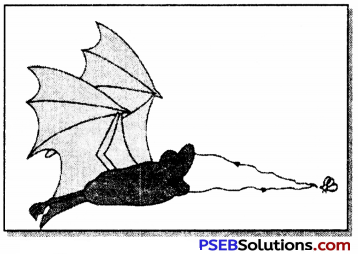
In darkness bats while flying in search of their prey emit ultrasound waves and then detect these waves after reflection. Very high-frequency ultrasonic squeaks of bat are reflected from prey and returned to bat’s ear. Amount and time delay of reflected wave helps bat in estimating the position and distance of prey.
![]()
Question 18.
How is ultrasound used for cleaning?
Answer:
Ultrasounds are used to clean parts located in hard-to-reach places e.g., complicated electronic components, watches, spiral or odd shaped parts. Appliances to be cleaned are placed in cleaning solutions and ultrasonic waves are sent through cleaning solution. Due to high frequency of ultrasounds, the dust, oil, grease and dirt get detached.
Question 19.
Explain the working and applications of SONAR.
Or
Write the full name of SONAR. How will you determine the depth of a sea using echo ranging?
Or
Write full form of SONAR. List any two purposes for which, it is used and explain its working for any one such purpose.
Answer:
SONAR: The acronym Sonar stands for Sound Navigation and Ranging. Sonar is a device that uses ultrasonic waves to measure the distance, direction and speed of underwater objects.
Principle: It uses the phenomenon of echoes in determining the sea-depth and locating the presence of underwater objects.
Working: Sonar consists of a transmitter T, and a detector D, installed below a ship as shown in Fig. The wave produced by transmitter travel through water and are reflected by sea-bed of obstacle. Reflected waves are sensed by the detector. Detector converts ultrasonic waves into electric signal. These signals are interpreted by detector.
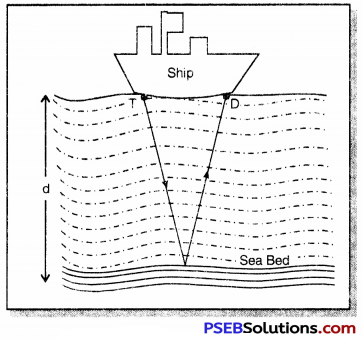
If time interval between transmission and reception is t and speed of sound in sea-water is v, then 2d = υ × t or d = υt/2, where d is the depth of the sea. This method is also called echo sounding.
Practical Applications: It is used to locate underwater submarines, icebergs, sunken ships and underwater hills etc.
![]()
Question 20.
A sonar device on a submarine sends out a signal and receives an echo 5 s later. Calculate the speed of sound in water if the distance of the object from submarine is 3,625 m.
Solution:
Time between emission of sound and its collection (t) = 5 s
Depth of sea (2d) = 2 × 3625 m = 7250 m
We know, 2d = Speed of sound × Time
7250 = Speed of sound × 5
∴ Speed of sound (υ) = \(\frac {7250}{5}\)
= 1450 m s-1
Question 21.
Explain how defects in a metal block can be detected using ultrasound?
Answer:
In industries metallic components are used in the construction of big structures like buildings, bridges, machines, scientific equipments, etc. ultrasounds (ultrasonic waves) are used to detect the internal defects or cracks in big metallic blocks which are not visible from outside.
Ultrasonic waves are allowed to pass through the metal block and detectors are used to detect the transmitted waves. If there is even a small defect, the ultrasound gets reflected back and does not reach the detector, as shown in figure. This indicates the presence of a defect.
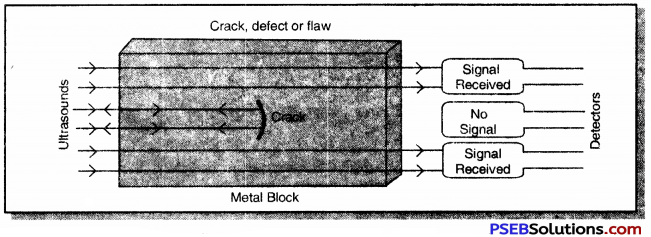
Question 22.
Explain how the human ear works.
Answer:
Ear is very sensitive device used to hear sound. It converts compressions and rarefactions of frequency range 20 Hz to 20,000 Hz into electric signals that travel to brain via auditory nerve.
The ear consists of three sections:
- the outer ear,
- the middle ear and
- the inner ear.
The outer ear consists of Pinna and Auditory Canal. Pinna is a cup-shaped fleshy part of the outer ear. Pinna collects and amplifies sound waves which then pass on the auditory canal. At the end of auditory canal, there is a thin membrane called tympanic membrane or eardrum. When compression reaches the eardrum, the pressure on membrane increases and the ear drum is forced inwards. When rarefaction reaches the eardrum, it moves outwards.
The vibrations are amplified by lever action of three bones called hammer, anvil and stirrup in the middle ear. In turn, the middle ear transmits the amplified pressure variations to the inner ear. The amplified pressure variations are converted into electric signals by cochlea in the inner ear. The electric signals generated are conveyed to the brain
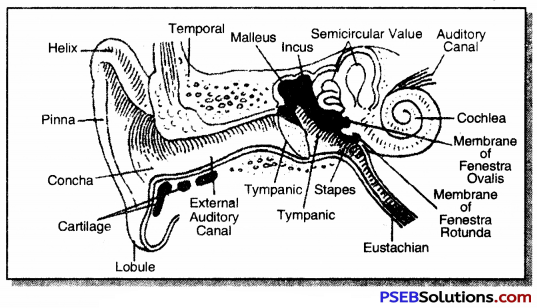
via the auditory nerve. The brain interprets them as sound. In fact we do not hear with ear. We hear with brain through ears.
Science Guide for Class 9 PSEB Sound InText Questions and Answers
Question 1.
How does the sound produced by the vibrating object in a medium reach your ear?
Answer:
When the vibrating object (such as tuning fork or school bell) moves forward then it compresses the air particles lying just ahead of it which results in production of high pressure region. This region is called compression. This pressure moves forward in the direction in which the object is vibrating, when this vibrat ing object moves backward then a region of low pressure is produced which is known as rarefaction.
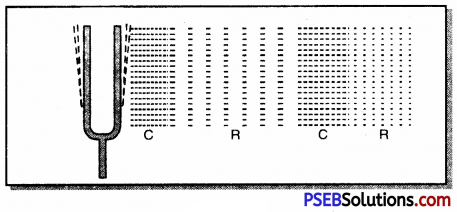
When the vibrating object rapidly moves to and fro then a series of compression and rarefaction pulses are formed i.e. sound wave is produced.
In this way the transmission of sound is caused in the form of transmission of change in density which reaches our ear and forces the tympanic membrane to vibrate. This produces the sensation of hearing in us.
![]()
Question 2.
Explain how sound is produced by your school bell?
Answer:
When the school bell is hit with a hammer, it begins to vibrate which produces sound waves. If we gently touch the bell, we feel vibrations. Wave is a disturbance which produces motion in the neighbouring particles of the medium. These particles handover the disturbance in the next particles lying close to the vibrating particles so that sound waves reach us. The particles of the medium do not move from one place to another, it is only the disturbance that travels forward.
Question 3.
Why are sound waves called mechanical waves?
Answer:
Sound is a kind of energy which cannot be produced by itself. To produce it some mechanical enery is required which may be by clapping or by striking bell with a hammer. This sound energy is transmitted in the form of waves by producing disturbance of the particles of the medium. Therefore, sound waves are called mechanical waves.
Question 4.
Suppose you and your friend are on the moon. Will you be able to hear any sound produced by your friend?
Answer:
For propagation of sound, air or some other material medium is required. On the surface of moon there is no such medium present as a result of which sound can not be propagated from one place to another place. So you can neither talk to your friend nor the sound produced by your friend can be heard by you.
Question 5.
Which wave property determines
(a) loudness
(b) pitch?
Answer:
(a) Loudness: The loudness of a sound wave is determined by its amplitude. The amplitude of sound wave depends upon magnitude of force. The more the force, the loud is sound produced. Loud sound traverses more distance because it has more energy in it. The more the sound is away from the source, the less is its loudness. Hence, loudness depends upon square of the amplitude.
(b) Pitch: The frequency of sound produced is called pitch. Frequency determines the aitch of a sound. The more is the vibration of the source, the higher will be its pitch.

So more the frequency, higher the pitch of sound.
In sound of high pitch the number of compressions passing through a fixed point in a unit time will be more.
![]()
Question 6.
Guess, which sound has a higher pitch: guitar or a car horn?
Answer:
Though sound of car horn is louder than that of guitar but guitar has higher pitch than car horn.
Question 7.
What are wavelength, frequency, time period and amplitude of a sound wave?
Answer:
1. Wavelength of wave: The distance travelled by the wave during the time, the particle of the medium completes 1 vibration is called wavelength.
Or
The distance between two consecutive compressions or rarefactions in a longitudinal wave or the distance between the consecutive crests or two consecutive troughs is called wavelength. It is denoted by a greek letter ‘λ’ (lambda). SI unit of wavelength is meter (m).

2. Frequency: In any medium when wave propagates the number of vibrations made by a particle of the medium is called frequency. It is denoted by ‘ν’. S.I. unit of frequency is Hertz (Hz). It is determined by the number of compressions or rarefactions passing through a fixed point.
3. Time Period: It is the time taken by a particle to complete one vibration during the propagation of wave. It is denoted by “T”. S.I. unit of time period is second.
Or
Time taken by two nearest compressions or rarefactions of sound waves to cross a point is called time period.
4. Amplitude: The maximum displacement of a particle of the medium on either side of mean position is called amplitude, of wave. It is denoted by letter ‘A’. For sound wave its unit is same as that of pressure or density. The loudness of sound depends on its amplitude.
Question 8.
How are the wavelength and frequency of a sound wave related to its speed?
Answer:
Velocity of sound wave (υ) = Wavelength (λ) × Frequency (ν).
![]()
Question 9.
Calculate the wavelength of a sound wave whose frequency is 220 Hz and speed is 440 m s-1 in a given medium.
Solution:
Velocity of sound wave (υ) = 440 ms-1
Frequency of sound (ν) = 220 Hz
Wavelength of sound wave (λ) = ?
We know, υ = ν × λ
440 = 220 × λ
or λ = \(\frac {440}{220}\)
or wavelength (λ) = 2 m
Question 10.
A person is listening to a tone of 500 Hz sitting at a distance of 450 m from the source of sound. What is the time interval between successive compressions from the source?
Solution:
Given frequency of sound (ν) = 500 Hz
Time taken between two successive compressions (T) = ?
We know, time period (T) = \(\frac{1}{\text { Frequency }(ν)}\)
= \(\frac {1}{500}\)
= 0.002 s
Question 11.
Distinguish between loudness and intensity of sound.
Answer:
Difference between Loudness and Intensity:
| Loudness | Intensity |
| 1. The loudness of sound is the measure of senstivity of ears. | It is the sound energy passing through a unit area in 1 second. |
| 2. The loudness of sound can not be measured. | The intensity of sound can be measured. |
| 3. For different observers the loudness of sound is different. | The intensity of sound is same for different persons. |
| 4. The loudness of ultrasonic and infrasonic waves is zero because they are inaudible. | There is a possibility of intensity in ultrasonic and infrasonic sound in ultrasonic and infrasonic sound waves. |
Question 12.
In which of the three media, air, water or iron sound travels the fastest at a particular temperature?
Answer:
Sound travels fastest in iron as compared to air and water. The velocity of sound in iron is 5950 m s-1, followed by water [1500 m s-1], air [350 m s-1],
![]()
Question 13.
An echo returned in 3 s. What is the distance of reflecting surface from the source? Given that the speed of sound is 342 m s-1.
Solution:
Velocity of sound (v) = 342 ms-1
Time taken for echo to be heard (t) = 3s
Distance travelled by sound (S) = υ × t
= 342 × 3
= 1026 m
i.e. sound takes 3 s to travel from source to reflecting surface and then back to source and during this time the distance travelled is 1026 m.
Distance between source and reflecting surface = \(\frac {1026}{2}\) m
= 513 m
Question 14.
Why are the ceilings of concert halls curved?
Answer:
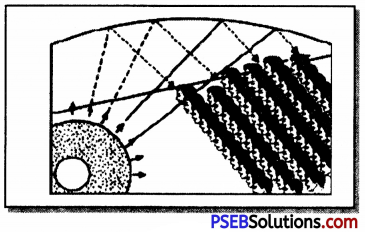
Ceilings of concert halls are made curved as is shown in Fig so that sound after reflection from all surfaces of hall may spread evenly to all parts and heard equally clear.
Question 15.
What is audible range of average human ear?
Answer:
For average human ear the audible range of sound is 20 Hz to 20,000 Hz.
Question 16.
What is the range of frequencies associated with
(a) infrasound
(b) ultrasound?
Answer:
(a) For infrasound the frequency range is less than 20 Hz.
(b) For ultrasound the frequency range is more than 20 KHz (i.e. 20,000 Hz)
![]()
Question 17.
A submarine emits a sonar pulse, which returns from an underwater cliff in 1.02 s. If the speed of sound in salt water is 1531 m s-1, how far away is the cliff?
Solution:
Time is taken by the sound to travel from submarine to cliff and back to the submarine
= 1.02 s
Speed of sound in saltwater = 1531 ms-1
Distance travelled by sound (2d) = Speed of sound × Time taken
= 1531 × 1.02 [∵ d is the distance between submarine and cliff]
= 1561.62 m
or d = \(\frac {1561.62}{2}\) m
i.e. Distance between submarine and cliff (d) = 780.81 m
